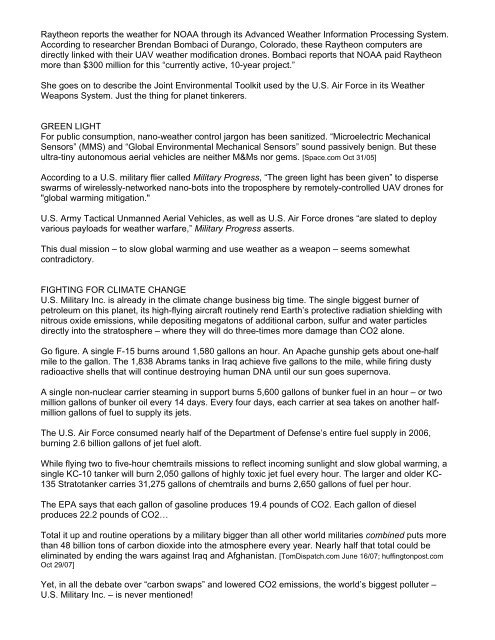CHEMTRAILS%20-%20CONFIRMED%20-%202010%20by%20William%20Thomas
CHEMTRAILS%20-%20CONFIRMED%20-%202010%20by%20William%20Thomas
CHEMTRAILS%20-%20CONFIRMED%20-%202010%20by%20William%20Thomas
You also want an ePaper? Increase the reach of your titles
YUMPU automatically turns print PDFs into web optimized ePapers that Google loves.
Raytheon reports the weather for NOAA through its Advanced Weather Information Processing System.<br />
According to researcher Brendan Bombaci of Durango, Colorado, these Raytheon computers are<br />
directly linked with their UAV weather modification drones. Bombaci reports that NOAA paid Raytheon<br />
more than $300 million for this “currently active, 10-year project.”<br />
She goes on to describe the Joint Environmental Toolkit used by the U.S. Air Force in its Weather<br />
Weapons System. Just the thing for planet tinkerers.<br />
GREEN LIGHT<br />
For public consumption, nano-weather control jargon has been sanitized. “Microelectric Mechanical<br />
Sensors” (MMS) and “Global Environmental Mechanical Sensors” sound passively benign. But these<br />
ultra-tiny autonomous aerial vehicles are neither M&Ms nor gems. [Space.com Oct 31/05]<br />
According to a U.S. military flier called Military Progress, “The green light has been given” to disperse<br />
swarms of wirelessly-networked nano-bots into the troposphere by remotely-controlled UAV drones for<br />
"global warming mitigation."<br />
U.S. Army Tactical Unmanned Aerial Vehicles, as well as U.S. Air Force drones “are slated to deploy<br />
various payloads for weather warfare,” Military Progress asserts.<br />
This dual mission – to slow global warming and use weather as a weapon – seems somewhat<br />
contradictory.<br />
FIGHTING FOR CLIMATE CHANGE<br />
U.S. Military Inc. is already in the climate change business big time. The single biggest burner of<br />
petroleum on this planet, its high-flying aircraft routinely rend Earth’s protective radiation shielding with<br />
nitrous oxide emissions, while depositing megatons of additional carbon, sulfur and water particles<br />
directly into the stratosphere – where they will do three-times more damage than CO2 alone.<br />
Go figure. A single F-15 burns around 1,580 gallons an hour. An Apache gunship gets about one-half<br />
mile to the gallon. The 1,838 Abrams tanks in Iraq achieve five gallons to the mile, while firing dusty<br />
radioactive shells that will continue destroying human DNA until our sun goes supernova.<br />
A single non-nuclear carrier steaming in support burns 5,600 gallons of bunker fuel in an hour – or two<br />
million gallons of bunker oil every 14 days. Every four days, each carrier at sea takes on another half-<br />
million gallons of fuel to supply its jets.<br />
The U.S. Air Force consumed nearly half of the Department of Defense’s entire fuel supply in 2006,<br />
burning 2.6 billion gallons of jet fuel aloft.<br />
While flying two to five-hour chemtrails missions to reflect incoming sunlight and slow global warming, a<br />
single KC-10 tanker will burn 2,050 gallons of highly toxic jet fuel every hour. The larger and older KC-<br />
135 Stratotanker carries 31,275 gallons of chemtrails and burns 2,650 gallons of fuel per hour.<br />
The EPA says that each gallon of gasoline produces 19.4 pounds of CO2. Each gallon of diesel<br />
produces 22.2 pounds of CO2…<br />
Total it up and routine operations by a military bigger than all other world militaries combined puts more<br />
than 48 billion tons of carbon dioxide into the atmosphere every year. Nearly half that total could be<br />
eliminated by ending the wars against Iraq and Afghanistan. [TomDispatch.com June 16/07; huffingtonpost.com<br />
Oct 29/07]<br />
Yet, in all the debate over “carbon swaps” and lowered CO2 emissions, the world’s biggest polluter –<br />
U.S. Military Inc. – is never mentioned!


